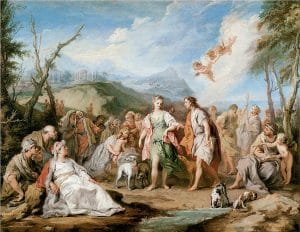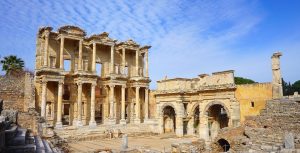Selcuk Castle
The Selcuk Castle is situated on a hill to the north of the church. It is a Byzantine structure, repaired during the Aydinogullari Emirate, which displays building techniques of various periods. The perimeter measures nearly 1.5 km. There are fifteen towers and a mosque dating from the 14th Century.
The main entrance gate of the castle was constructed from the stones of Roman buildings in the 6th century AD. The Selcuk castle has 15 towers and is surrounded by rubble-stoned city walls reaching 1.5 km. A church, built into a former Byzantine church, a small mosque, and several cisterns are within the borders of the citadel of Ayasuluk. Also, it was proved from the remaining sub-Mycenean graves belonging to the 14th century BC, that the hill was used as a necropolis.
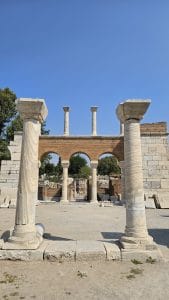
From the 7th to the 9th century, the city of Ephesus was divided between the harbor town and the citadel on the hill, a mile away. Both were designed for defense against constant attacks by Arabs and pirates. The walls around St. John’s Basilica were reinforced, using marble blocks from the previous site of Ephesus. The combination of the marble facade and the mortar rubble made the walls 4m thick. The citadel walls are 1.5 km around with 15 towers in the castle.
Entry to the castle from the south is through the Gate of Persecution, which leads into the Basilica. The gate used to have a frieze of Odysseus discovering Achilles, and when it was mistakenly thought to depict the persecution of Christians, the gate acquired its name. In the 8th century, the square towers on either side of the gate were made pentagonal, aiding in their defensive capabilities.
The location of Ephesus changed over the years, for various reasons, including the changing course of the Cayster River as well as the need to defend itself against invasions. The history of Ephesus is a fascinating one, as it had great religious and military importance to many different people throughout the changing of empires. Selcuk is the present-day name for Ephesus, and the history of the castle is closely tied to that of the city. As the Selcuk castle was located at a significant point it was rebuilt and expanded in the Selcuk and Ottoman eras.
Excavations in the castle were carried out by the Ephesus Museum in 1960. The second-period excavations were started in 1990 and continued by the Museum until 2003. Later, Ayasuluk Hill, St. Jean Basilica, or together with Ayasuluk Hill and St. Jean Monument Excavation and Repair Works from Pamukkale University Archeology Department asst. Assoc. Dr. He was given the responsibility of a scientific team headed by Mustafa Buyukkolanci.
In these excavations, the southern slope houses, roads, castle mansions, and baths were excavated and unearthed in the inner castle. With the support of the Selçuk Municipality, extensive repair works were initiated on the western city walls in 2010. As of 2020, Ayasuluk Hill and St. Jean Monument Excavation and Repair Works Hatay Mustafa Kemal University, Faculty of Arts and Sciences, Department of Art History. Instructor It is carried out by its member Sinan Mimaroglu.
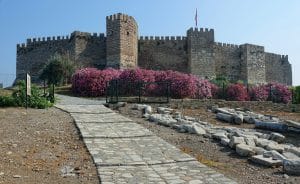 The main purpose of the excavations is to illuminate the history of Ephesus, which is considered to be extremely important in terms of Anatolian and World archeology, and to shed light on the prehistoric periods of the region.
The main purpose of the excavations is to illuminate the history of Ephesus, which is considered to be extremely important in terms of Anatolian and World archeology, and to shed light on the prehistoric periods of the region.
The main purpose of the excavations is to illuminate the history of Ephesus, which is considered to be extremely important in terms of Anatolian and World archeology, and to shed light on the prehistoric periods of the region.
It is the main building phase of the Byzantine Period, which was used in the 5th and 6th centuries AD, defined as the Episcopal Palace. There is also a cistern, defined as the Great Cistern or AN structure, in the southeast corner of the outer walls. The building is 32.66 x 30.07 meters from the outside and 27.20 x 25.80 meters from the inside. It is understood that the water was brought to the cistern by aqueducts. The aqueducts bring the water from the water sources east of the Pranga Mevkii between Belevi and Selcuk to the settlement of Ayasuluk Hill. Today, they have survived to a height of 15 meters in places.
Ayasuluk Castle, seen today, is a Seljuk-Ottoman castle. Like the outer walls, the Inner Castle was built using rubble stones and spolia and was reinforced with 15 towers. The Inner Castle has two entrances, one on the west and one on the east. The western gate should be protected by overhanging walls.
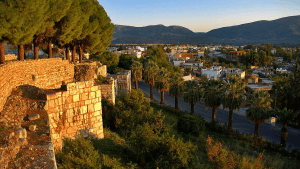 There are five cisterns in the Inner Castle. One of them is the eastern (apse) part of the basilica built during the Byzantine Period. The building, known as the Basilica of St. Jean, was built by the Byzantine Emperor Justinian I between 527 and 565. The basilica was converted into a cistern when the castle passed under Turkish control. A bath was built next to it.
There are five cisterns in the Inner Castle. One of them is the eastern (apse) part of the basilica built during the Byzantine Period. The building, known as the Basilica of St. Jean, was built by the Byzantine Emperor Justinian I between 527 and 565. The basilica was converted into a cistern when the castle passed under Turkish control. A bath was built next to it.
An important structure in a dominant position in the castle was reached during the 2009 excavations. Stone, brick, and lime mortar were used in the structure, which measures 11.0 x 10.2 meters from the outside and 9 x 8 meters from the inside. Marble was used in the construction of the east and south doors.
The vineyard motifs, which are used as decorative elements on the doors, are similar to the decorations of the Isa Bey Mosque inside the castle. For this reason, it is thought that this structure, which is defined as a castle mansion, and the mosque were built in the same period and by the same stone masters. It is understood that the building in question is the two-story building in the engraving of the English traveler J. Covel, who came to Ayasuluk in 1670.
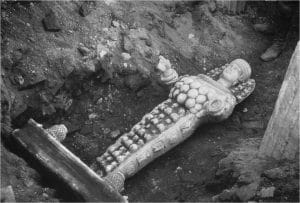 However, it is thought to have been demolished between these two dates, as it was not seen in an engraving dated 1690. It is claimed that the castle mansion was built in 1375 by Fahreddin Isa Bey, who had the Isa Bey Mosque built, between 1350 and 1390, when Ayasuluk was the capital of the Aydinogullari Principality.
However, it is thought to have been demolished between these two dates, as it was not seen in an engraving dated 1690. It is claimed that the castle mansion was built in 1375 by Fahreddin Isa Bey, who had the Isa Bey Mosque built, between 1350 and 1390, when Ayasuluk was the capital of the Aydinogullari Principality.
Daily life in Ephesus – About Ephesus
- Ephesus Gods and Goddess
- About Ephesus history
- Festivals in Ephesus ceremony and procession
- Ephesus city management
- Sex life in Ephesus
- Burial in Ephesus
- How was childhood in the ancient city of Ephesus in Greek and Roman times?
- What did women do for their beauty in ancient Ephesus?
- How was the Marriage? Get married in daily life in Ephesus
- Ancient Ephesus food beverage cuisine and meal
- Gladiators in Ephesus
- Clothing and fashion in Ancient Ephesus
- Ephesus The Comedy of Errors – Shakespeare
- St. Paul in Ephesus
- Virgin Mother Mary in Ephesus
- Ancient Ephesus Marbles
- Ancient Ephesus History
- Slavery in Ephesus
- Ephesus Council – Biblical Ephesus
- Ephesus Temple, Ephesus Offerings Votives


